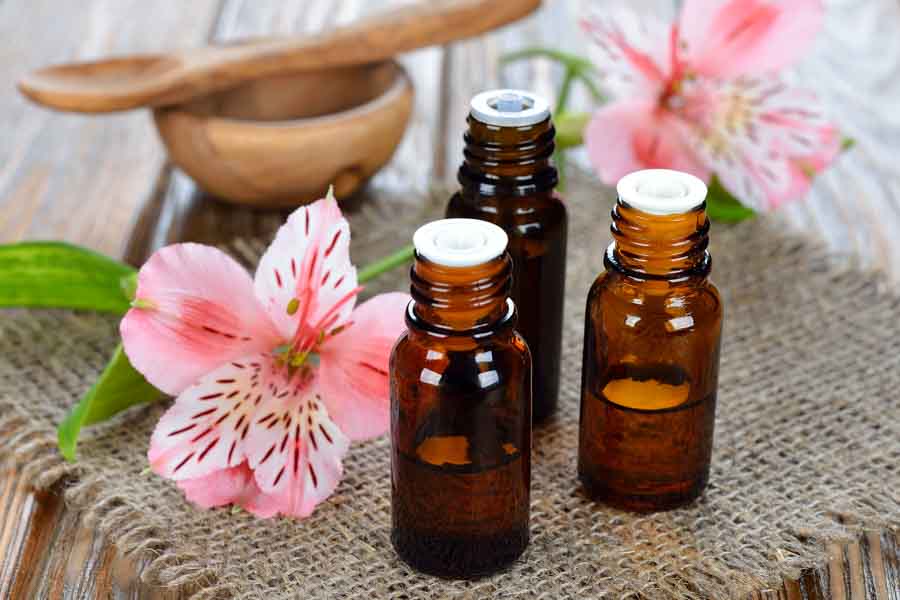
If you think geranium is just another pretty flower, think again! With their variety of colors, geraniums used to be grown for decorative purposes. Today, not only do they serve as pretty pot-fillers, but are also cultivated for their fragrant essential oil.
Geranium oil is known for its rose-like scent, and it has been used for a variety of purposes ranging from perfumery to wellness. So what exactly is geranium oil? What are its uses and benefits? Read on to find out more about this sweet-smelling essential oil.
History & Origins of Geranium Oil
The earliest mentions of geranium dated back to the Egyptians, who were said to use the plant extracts to beautify the skin. They also used it to treat a number of ailments ranging from skin diseases to cancerous tumors.
In the Victorian era, the geranium plant was then introduced to Europe from South Africa, where it gained popularity among the social classes. Its edible leaves and flowers often found their way to desserts, jellies, teas, and other sweet treats. Dining places often had geranium leaves or potted plants, with its colorful flowers as decoration and its leaves for guests who wished to consume a fresh sprig.
The first recorded distillation of geranium oil was done by a French chemist named Recluz in 1819. From then on, other researchers took an interest in the oil, including a chemist and botanist named Demarson. He then conducted studies to discover the best geranium varieties for producing quality geranium oil. These investigations then led to the use of the fragrant oil for health and wellness.
Geranium oil closely resembles rose oil in scent. Because of this, geranium oil is sometimes used to extend or adulterate rose oil, which is about six times more costly than geranium oil. In many cosmetics and perfumes, geranium oil has also been used to create or enhance a rose-like scent. Some have even referred to it as the “poor man’s rose” because of their shared characteristics with the more expensive rose oil.
Today, geranium oil is known for its delicate floral fragrance and its benefits for the skin and emotional well-being.
What are Some Benefits of Geranium Essential Oil?
Though geranium oil has not been as popular as many of the other essential oils, today it has found its place as one of the more delicate floral oils that can promote both emotional and physical wellness.
Geranium oil’s calming aroma generally brings about a sense of peace and relaxation. Because of this, it is widely known for supporting positive feelings and decreasing anxiety. It also helps in managing overwhelming emotions like anger and fear. Aside from its emotional benefits, like many oils, it can aid in a number of beauty problems and health concerns. Among these would be skin problems, wounds and cuts, fungal infections and inflammatory conditions. Its many beneficial uses make it a first-aid kit in itself!
Specific Benefits of Geranium Oil

1.) It reduces stress and tension
Having a rough day? Geranium oil’s calming scent brings about uplifting emotions, driving away any stress and tension you may be feeling throughout the day. Its floral, relaxing scent also makes it ideal in driving away anxiety, depression, fatigue, or even just an overly cluttered mind. Run geranium oil through your diffuser, or even take a soothing cup of tea brewed from its leaves to benefit from its de-stressing properties.
Related: 14 EOs for High Blood Pressure
2.) It speeds up healing for wounds, cuts and bruises
Geranium oil comes in as a handy first-aid application to wounds and cuts. It helps speed up healing, first by virtue of its ability to stop wounds from bleeding, and second, by being able to promote tissue regeneration. Because of this, applying it immediately to cuts, scrapes, bruises and incisions can help with blood clotting and faster healing. You can apply it as is, or use as a salve or ointment in combination with other healing oils like eucalyptus and lavender.
Related: 11 EOs for Healing Scars
3.) It helps fight skin infections
Aside from healing wounds, geranium oil also helps protect open wounds from invading bacteria that cause infections. Its antiseptic action wards off any germs and fungi that can lead to complications at the wound or incision site. Simply dab on a drop or two of the oil onto the affected area and cover with a sterile gauze bandage.
4.) It treats skin diseases
By virtue of its tissue regeneration properties, it can help treat skin conditions like acne and dermatitis. Its antibacterial action helps prevent bacterial growth that leads to acne, while its anti-inflammatory property helps keep dermatitis, eczema, pimples and psoriasis at bay. To use geranium oil for this purpose, you can simply add a drop or two to your usual face or body wash. You can also mix together five to eight drops of geranium oil in a teaspoon of coconut oil (or other carrier oil) and apply this to the affected areas at least twice a day.
5.) It can help ease insomnia
Being a calming agent to the nervous system, geranium oil also has sedative properties that help promote sleep. Rubbing a drop of oil between your hands and inhaling the aroma can help bring about feelings of relaxation and sleep. Diffusing the oil throughout your bedroom can also help you sleep easier and promote better sleep quality.
Related: 17 EOs for improved sleep
6.) It aids in nerve pain and shingles relief
Studies have found that geranium oil can significantly reduce nerve pain especially associated with shingles, a condition brought about by the herpes virus. The oil can be applied to the painful areas on the skin to offer relief. Plus, its anti-viral property can also aid in killing off the shingles virus for a faster recovery. You can also mix together a few drops of geranium oil with other anti-viral oils like bergamot or clove oil in a carrier oil and use this mixture as a massage on the area where nerve pain is felt.
7.) It soothes PMS symptoms
Premenstrual syndrome (PMS) is that time of month where hormonal imbalances often bring about mood swings, irritability, abdominal cramps and bloating in women. Geranium oil’s calming properties along with its ability to balance hormones makes it useful for coping with PMS. Plus, it can also help with some menopause symptoms. Dab some geranium oil diluted with a carrier on your pulse points to ease irritation and mood swings, and massage some on your abdomen to help relieve boating and crampy sensations. Try out our DIY recipe too for PMS relief.
Related: EO Remedies for PMS & Menstrual Cramps
8.) It helps reduce wrinkles
Wrinkles are caused by sagging skin that has lost a certain degree of elasticity. Geranium oil’s astringent effect allows skin tissues to tighten and contract, significantly reducing the appearance of wrinkles. Additionally, its antioxidant effects also help slow down skin aging, helping you look younger. You can simply add two drops of geranium oil to your daily facial moisturizer applied twice daily for an anti-wrinkle effect.
9.) It aids in blood clotting and treats hemorrhoids
Geranium oil is a styptic, which is an agent that can contract tissues and blood vessels, thereby checking or stopping bleeding. This enhances the process of blood clotting, thereby aiding in wound healing and preventing toxins and bacteria from further entering the body through an open wound. It is also beneficial for treating hemorrhoids, especially those that bleed. The oil can help by contracting the swollen veins to stop the bleeding and helping to shrink the swollen tissue. Taking in a drop of the oil with about 100 ml of liquid or a teaspoon of honey may help. You can also apply it topically on bleeding cuts and hemorrhoids by mixing two drops of geranium oil with a teaspoon of carrier oil or cold cream and applying this on the affected area.
Related: 11 EOs for Hemorrhoids
10.) It’s a powerful anti-inflammatory
Almost all health conditions involve inflammation in one way or another. From arthritis to heart disease to cancer, it is the most common culprit of many diseases. Various studies have come up with new information about chronic inflammation, how it adversely affects our health, and what can be done to prevent it.
Geranium oil has the ability to block various inflammatory processes in the body. Geraniol, in particular, increases the body’s production of anti-inflammatory substances to naturally fight off inflammation and prevent it from causing diseases. Such actions potentially make geranium oil a significant component of anti-inflammatory formulations and new drugs that are safer than current medications. Be it for the skin, joints, or to fight other inflammatory manifestations of disease, geranium oil can be taken internally every day. It has been regarded as safe for consumption by the US FDA. You can take one drop with a teaspoon of honey or mixed with liquids like almond milk.
11.) It helps in skin regeneration and renewal
Aside from keeping wrinkles in check, geranium oil also helps keep your skin young and glowing by renewing blemished tissues. It can help fade acne scars and tone down the appearance of dark spots by promoting a balanced distribution of melanin, the pigment responsible for skin darkening. Ideal for dry, aging or sensitive skin, its many skin renewing benefits have made it a favorite component of many skin lotions, tonics and moisturizers. Add a drop or two to your daily moisturizer and observe as your skin starts to look and feel healthier.
Related: 7 EOs for Cellulite
12.) It soothes digestive problems
Stomach cramps and bloating always make for uncomfortable hours with your belly scrunched up. A warm cup of geranium tea brewed from the leaves or containing a drop of geranium oil can help soothe an upset stomach and get gas moving along. It can also help eliminate bacteria that could be causing the irritation and get stomach function back to normal.
13.) It improves kidney health
Geranium oil is a natural diuretic, a substance that can help promote urination. This helps your kidneys eliminate toxins like heavy metals and excess salts from the body. It also helps maintain water balance in the body and reduce edema, or swelling due to fluid retention.
14.) It can help relieve muscle strains and pains
Because of its anti-inflammatory properties along with mild painkilling action, geranium oil can be used to massage tired muscles and sore joints. It can also be used to help soothe headaches and migraines due to its analgesic activity. Taking a freshly brewed tea from geranium leaves or adding one drop of the oil to your usual cup of tea can help release endorphins, the body’s natural pain relievers.
Related: 9 EOs for Sore Muscles / Muscle Pain
15.) It can ease allergies
A recently-conducted Japanese study has shown that components in geranium oil were able to block the cells that trigger allergic reactions in the body. These same cells are also involved in other conditions like inflammatory ailments and autoimmune disorders, showing that geranium oil may also help regulate the immune system. Rubbing a drop between your palms and inhaling the oil vapor may help relieve the itching and watery secretions that come with allergies.
Related: 9 EOs for Allergies
16.) It boosts mental clarity and concentration
If you’re feeling mental fatigue creeping up in the middle of a work day, geranium oil can help improve focus and cognitive function. It has also been studied for its role in preventing dementia and Alzheimer’s disease, two of the most common neurodegenerative diseases that affect memory and mental functioning. You can simply inhale the oil from your palms, an inhaler or a diffuser to get a boost to concentrate on tasks at hand. You can also massage the oil diluted with a carrier over your temples and the back and sides of your neck for a soothing effect.
Related: 5 EO Blends for Focus & Concentration
17.) It can help treat fungal problems
Application of geranium oil has been found to help anti-fungal medications work better. Fungal problems like athlete’s foot, jock itch, and vaginal candidiasis (yeast infections) can benefit from the application of geranium oil on the affected areas as an aromatic wash. Add five to ten drops of geranium oil to warm water and use this to wash the affected areas. You can also add it into your warm bath and soak in the tub while enjoying its sweet, floral aroma. For athlete’s foot, you can make an Epsom salt foot bath with five to ten drops of the oil.
18.) It can help in lowering blood sugar
Researchers have found that geranium oil was able to significantly decrease high levels of blood glucose in diabetes-induced rats, and was even more effective than a certain anti-diabetic drug! Though studies in humans still have to be done, this shows that geranium oil has the potential to help lower blood sugar levels for those at risk of diabetes. Massaging the oil onto the soles of the feet may help the oil be absorbed into the bloodstream. Consuming a drop with 3-4 ounces of liquid a day may also help.
19.) It can help heal cold sores
Cold sores from the herpes simplex virus can be painful and uncomfortable. Geranium oil with its anti-viral properties can help speed up healing from this condition. Plus, its ability to soothe pain can also help in managing the discomfort. Dab some geranium oil diluted with a carrier oil directly onto the cold sore. You can also take in the oil internally diluted with about 3-4 ounces of a liquid (like almond milk or tea) to support immune function.
Related: 5 EO Remedies for Cold Sores
Things to Keep in Mind when using Geranium Oil
Geranium oil is non-toxic and is generally safe for application to the skin in dilute amounts. In some people with sensitive skin, however, it may cause some irritation such as redness, rashes and itching. As with all essential oils, be sure to test a small amount first on your forearm and observe for any signs of irritation before using it. Also, it’s best to avoid application in babies. When using in young children, it should be used at half-strength or be well-diluted.
Because geranium oil has some effects on hormone secretions, it should not be used in women who are pregnant or breastfeeding. As with other essential oils, it’s also best to avoid its use if you have hypertension, epilepsy or other conditions. Talk to your health care practitioner for safety advice regarding its use if you have any other health conditions.
The uplifting fragrance of geranium oil can be complemented by other oils like bergamot, lavender, chamomile, rosemary, ylang-ylang, clary sage, jasmine, grapefruit, clove, and frankincense. Geranium oil is also safe to take internally as long as it is well-diluted with about 3 to 4 ounces or 100 ml of liquid per drop of oil. In fact, it may be added to various foods like candies, beverages, baked products, and dairy.
Geranium Oil Application Tips
Geranium oil’s many benefits can be obtained in a variety of ways. Here are some nifty tips for using this sweet-scented oil.
- Add a drop to your daily moisturizer for skin renewal and to reduce wrinkles. This also helps regulate oil production.
- Dab a few drops diluted with a carrier oil on your pulse points for an uplifting fragrance throughout the day. This also helps reduce stress and tension when you know you’re in for a rough time ahead.
- Add a few drops into your aromatherapy skin facial to allow the skin to absorb its regenerative and skin-balancing properties.
- For a feminine scent for your closet, place a few drops on cotton balls and leave these in your closet.
- For an aromatic tub soak, place about ten drops into the tub with your warm bath water. Add in some rose petals for that extra-goddess effect!
Geranium oil Recipes

1.) Anti-aging face serum
Ingredients:
- 2 drops geranium essential oil
- 2 drops lavender essential oil
- 2 drops sandalwood essential oil
- 2 drops rose essential oil
- 2 drops helichrysum essential oil
- 2 drops frankincense essential oil
- 2 tablespoons of carrier oil (argan, coconut,sesame, sweet almond, jojoba, grapeseed, macadamia)
Directions:
- In a dark-colored 1-ounce glass dropper bottle, carefully place the carrier oil.
- Add in each of the essential oils, shaking gently after each addition.
- Store in a cool, dark place.
- To use, cleanse and tone face first. Then, shake the bottle well and get a couple drops of the serum. Massage onto wrinkles fine lines, age spots, and other problem areas. Then, moisturize as usual.
All-around healing salve
Ingredients:
- 5 drops geranium essential oil
- 6 drops lavender essential oil
- 5 drops cedarwood essential oil
- 5 drops tea tree essential oil
- 1/4 cup almond oil
- 1/2 cup jojoba oil
- 3/4 cup tamanu oil
- 2 tablespoons neem oil
- 1 ounce beeswax
Directions:
- 1. Place the double boiler on low heat and put beeswax in the upper part until it melts.
- 2. Add in the almond, jojoba, tamanu and neem oil. Stir.
- 3. Remove from heat and allow to cool for a few minutes.
- 4. When just about warm (not too cool that the beeswax solidifies), add in each of the essential oils, whisking well after each addition. Mix well when all the oils are added.
- 5. Pour into a tin can or glass jar and allow to cool with occasional stirring.
- 6. Store in a cool, dry place.
- 7. To use, apply a small amount on wounds, cuts, scars and bug bites.
3.) Anti-aging facial scrub
Ingredients:
- 2 drops geranium essential oil
- 1 drop frankincense essential oil
- 1 drop lavender essential oil
- 1/2 tablespoon raw organic honey (preferably manuka honey)
- 1 tablespoon baking soda
Directions:
- 1. In a small bowl, mix together the honey and baking soda until a paste is formed.
- 2. Mix in the essential oils.
- 3. To use, first splash your face with warm water or apply a warm washcloth for a minute to open up the pores.
- 4. Apply the facial scrub gently all over your face, massaging in a circular motion while avoiding the eye areas. Do this for about 3-5 minutes.
- 5. Rinse the scrub off with warm water and pat dry.
4.) PMS relieving massage blend
Ingredients:
- 12 drops geranium essential oil
- 4 drops mandarin essential oil
- 5 drops lavender essential oil
- 15 drops cedarwood essential oil
- 1/2 cup of carrier oil such as sweet almond, grapeseed or sunflower oil
Directions:
- 1. In a clean, dry bottle, mix together all of the ingredients. Stir or shake well and leave overnight to blend.
- 2. Cover and store in a cool, dry place.
- 3. To use, massage onto your belly and lower back in a clockwise manner. Use daily about a week before the menstrual period starts.
5.) Geranium aromatherapy moisturizing bar
Ingredients:
- 10 drops geranium essential oil
- 5 tablespoons candelilla wax
- 2 packed tablespoons raw, unrefined shea butter
- 3 tablespoons raw, organic cocoa butter
- 1/4 cup extra virgin olive oil
Directions:
- 1. In a double boiler, place the shea butter and melt over low heat for about ten minutes (this prolonged heating time prevents the resulting bar from becoming grainy when cooled).
- 2. Mix in cocoa butter and candelilla wax, allowing these ingredients to melt completely.
- 3. Stir together when fully melted, then stir in the extra virgin olive oil.
- 4. Remove from heat and allow to cool until just about warm but not solidified.
- 5. Add in the geranium essential oil and mix well.
- 6. Pour into molds and allow to cool.
6.) Soothing skin toner
Ingredients:
- 5 drops geranium essential oil
- 5 drops lavender essential oil
- 2 ounces green tea infusion (1 green tea teabag is enough)
Directions:
- 1. Prepare the green tea infusion by steeping a teabag of green tea in hot water for 5-10 minutes.
- 2. Allow the green tea to cool.
- 3. Transfer to a glass bottle and add in the essential oils. Mix well or shake.
- 4. Let stand overnight to allow the oils to blend in with the green tea.
- 5. To use, place a small amount on a cotton pad and apply to the face after cleansing.
7.) Mood balancing perfume
Ingredients:
- 3 drops geranium essential oil
- 3 drops bergamot essential oil
- 2 drops lavender essential oil
- 2 tablespoons carrier oil of your choice
Directions:
- 1. Place your chosen carrier oil in a dry glass container.
- 2. Mix in each of the essential oils and shake well to blend.
- 3. To use, dab a few drops on your pulse points such as those in your neck, wrists and the inside of your elbows to balance mood and uplift the emotions.
8.) Shingles relief massage blend
Ingredients:
- 30 drops geranium essential oil
- 10 drops peppermint essential oil
- 20 drops helichrysum essential oil
- 20 drops juniper berry essential oil
- 12 drops cypress essential oil
- 2 ounces carrier oil of your choice like almond, sunflower, tamanu or fractionated coconut oil
Directions:
- 1. Place your chosen carrier oil in a clean, glass bottle that can accommodate 2 ounces or more.
- 2. Add in each of the essential oils, stirring or shaking after adding each of the oils.
- 3. When all the ingredients have been added, cover the bottle tightly and shake well.
- 4. Apply to areas affected by nerve pain. This can also be used on aching joints and sore muscles.
Source and Composition of Geranium oil
Though geranium essential oil is a floral oil, it is actually obtained from the leaves of Pelargonium graveolens, from the plant family Geraniaceae. Geraniums, also known as pelargoniums, have over 200 species. Botanically, they appear as shrubs with variously-shaped long-stemmed leaves and small flowers ranging from pink to a vivid orange-red. The name “pelargonium” is said to be a reference to the stork-bill shape of the plant’s fruits, from the Greek word “palargos,” meaning stork.
The particular species used for producing geranium oil is also called the rose-scented geranium, so as not to be confused with other types, which produce a variety of different scents.
The delicately-fragranced geranium oil is obtained by steam distillation, where the leaves have to be gathered before the flowers open for a more pronounced fragrance. The resulting oil contains a variety of compounds, with citronellol and geraniol being the main components. Such components are also present in rose oil, which explains the similarity of the two in scent and in therapeutic properties.
Geranium oil also contains a certain amount of flavonoids, with a compound called quercetin in the highest amounts. Flavonoids are active compounds having various healing properties, and quercetin in particular has been studied for its anti-inflammatory, antiseptic, antioxidant and other beneficial actions.
The rose-scented geranium is native to South Africa, but cultivation has spread to the Middle East, Asia and other countries for its valuable essential oil. The best quality oil is said to come from the country of Reunion, a French island colony in Africa, where the oil is referred to as geranium Bourbon-La-Reunion or geranium “Bourbon” oil. This oil is now used as the reference for judging the quality of geranium oil. Other good quality geranium oils are sourced from Egypt and Madagascar, among others.
Conclusion
Geranium oil offers a multitude of benefits not just for the skin, but for a number of body systems and functions as well. Hopefully, this article has helped you know more about this delicate oil and has inspired you to use it for a variety of recipes to aid in your health and well-being!










